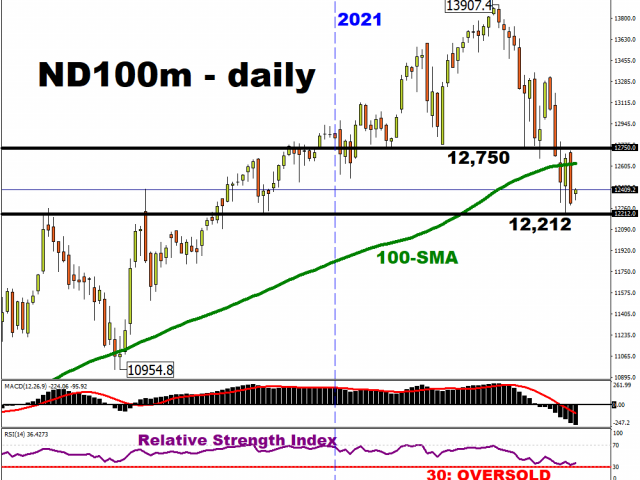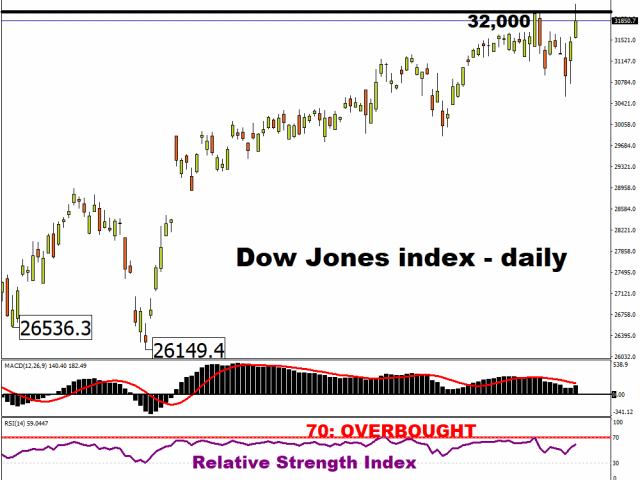The Dow Jones index climbed 0.97% while the Nasdaq 100 tumbled 2.92% on Monday. The Dow now has a year-to-date advance of 3.91%, while the Nasdaq 100 is down 4.57% so far in 2021.
The rotation in US stocks is certainly chugging along, further evidenced by Monday’s contrast in performance between the Dow Jones index and the tech-heavy Nasdaq 100. The tech rout was the major contributor to how benchmark US indices performed at the onset of the week.
The Nasdaq 100 has now marked a technical correction, which is to say that Monday’s closing price is now more than 10% lower from its record high on 12 February; 10.93% lower to be more precise.
At the time of writing, the futures contracts for the Nasdaq 100 are now trying to shed off that label of falling into a technical correction, edging slightly higher.
Some have said that this correction is long overdue, considering the stellar gains that tech stocks have enjoyed since the pandemic. While it was indeed a time of immense profit-taking, it’s still hurting shareholders who are still holding on, unsure how long this rout will last.
Reasons for the Rout
- The tech selloff is being triggered by concerns that faster US inflation could encourage an interest rates liftoff by the Fed. When borrowing costs rise, that may hamper the performance of these tech stocks which had clearly benefitted from the record low interest rates at present. Investors will get to assess their inflation expectations when the February US consumer price index is released on Wednesday, to see how much this narrative holds.
- US President Joe Biden’s $1.9 trillion fiscal stimulus plan is set to be passed by the House this week. And that huge swath of government spending is set to benefit other sectors, such as energy, financials, and industrials, all of whom still lag tech on a 12-month basis. With hopes for the US economic recovery running high, investors are now rotating their funds out of the once-darlings of the stock market and into other sectors which are expected to benefit from more fiscal stimulus.
- Tech stocks were seen to be highly overvalued. Even after Monday’s tumble, the Nasdaq 100’s price-to-earnings (PE) ratio is still around 36, which is higher than the Dow’s at 28. Also, the Nasdaq 100’s PE ratio at present remains higher than its 10-year average of 23.
That gap suggests that there’s still more room for tech stocks to fall.
Stock rotation is benefitting the Dow
The Dow was the only major US benchmark that ended in the green yesterday, with Disney shares soaring 6.27% to lead the charge at the top. In contrast, Apple’s 4.17% decline made it the biggest loser on the Dow yesterday. Note that Disney alone accounts for over 4% of the Dow Jones index while Apple’s weightage is 2.4%.
The Dow actually posted a new intraday record high, but ended the session just 0.5% away from its highest ever closing price that was registered on 24 February.
The fact that the Dow was able to climb on Monday, while the S&P 500 and the Nasdaq 100 declined was due to the smaller weightage for tech stocks on the Dow. The IT sector accounts for around 21% of the Dow, where else over 26% of the S&P 500 comprises of tech stocks.
Should this rotation continue, and with just a 160-point gap to overcome, it’ll be no surprise if the Dow posts a new record high sometime this week.
Disclaimer: The content in this article comprises personal opinions and should not be construed as containing personal and/or other investment advice and/or an offer of and/or solicitation for any transactions in financial instruments and/or a guarantee and/or prediction of future performance. ForexTime (FXTM), its affiliates, agents, directors, officers or employees do not guarantee the accuracy, validity, timeliness or completeness, of any information or data made available and assume no liability as to any loss arising from any investment based on the same.




